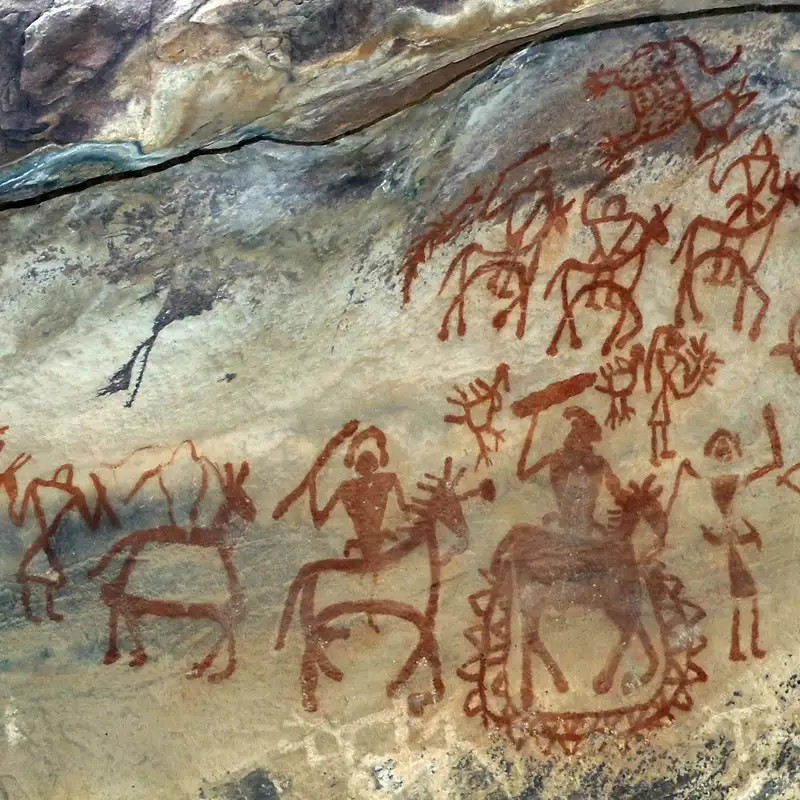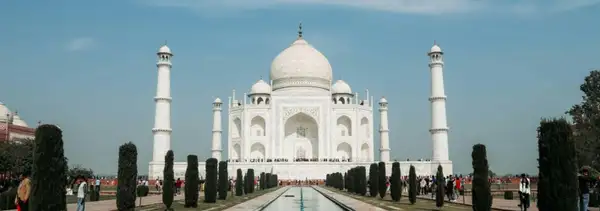Bhimbetka Cave paintings from 30000 years ago!
Hey, everyone. Welcome back to the Incredible India podcast series. I'm Tim.
Debbie:And I'm Debbie.
Tim:And today, well, we're setting off on a really fascinating journey through time and art in India.
Debbie:That's right. We're focusing on two incredible the ancient Pimbetka cave paintings and the, really impressive Bhojpura Temple.
Tim:Yeah. We've got some great information lined up. Our mission really is to dig into this material and pull out the most compelling bits for you. We want to give you a clear sense of why these sites are so historically and culturally important.
Debbie:We're talking about prehistoric art, potentially 30,000 years old, and then jumping forward to a magnificent eleventh century temple. It's quite the leap.
Tim:It really is. We'll try and connect these different eras and, you know, maybe uncover something about the enduring human spirit along the way.
Debbie:Sounds good. So where should we start? Pembetka, maybe?
Tim:Let's do it. Betka. It's a UNESCO world heritage site. Right? Which already tells you something special.
Tim:Oh, absolutely. And the scale is just Yeah. Immense. It's one of the largest prehistoric complexes known anywhere in the world. Yeah.
Tim:We're talking over 750 rec shelters.
Debbie:750.
Tim:Wow. Yeah. Spread across seven hills. So it's not just a few caves. It's this huge outdoor gallery, really.
Debbie:A gallery etched with stories from, well, potentially 30,000 years ago, placing it right in the old stone age.
Tim:Exactly. Yeah. And that age is just staggering to think about. I mean, people living back then
Debbie:Mhmm.
Tim:Concerned with survival, obviously, but also taking the time to create art in these natural rock shelters.
Debbie:It really makes you wonder about their lives, their thoughts.
Tim:It does. And it's like a palimpsest, you know, layers upon layers of art. It gives us this tangible record of how humans saw their world, how that changed over millennia.
Debbie:So what kind of things did they paint?
Tim:Well, earliest ones often show animals. Lots of animals.
Debbie:Oh, okay.
Tim:Right? Reflects their world, their food sources, maybe even things they revered. Then you start seeing scenes of human activity. Hunting is a big one.
Debbie:Right. Like a window into their daily lives, their struggles and successes.
Tim:Precisely. Yeah. But it doesn't stop there. That's what's so fascinating. Oh, yeah.
Tim:Later on, you get different images superimposed or added nearby. Things like warriors
Debbie:Mhmm.
Tim:Sometimes on horseback.
Debbie:On horseback. So that's much, much later then. Bronze Age, maybe?
Tim:Potentially. Yes. Yeah. It just shows continuous use over vast periods. It's like reading different chapters of history written on the same rock face.
Debbie:Amazing. And it wasn't just animals and hunting forever?
Tim:No. The themes evolved. You start seeing what looked like religious symbols, even sort of magical creatures or hybrid figures.
Debbie:Really? So you get glimpses into their beliefs, their imagination too?
Tim:Definitely. And the colors. They use natural pigments, minerals, and such, and the way they've lasted.
Debbie:Incredible. Protected by the rock overhangs, I guess.
Tim:It's a big part of it. Yeah. It's just this amazing insight into human life from the stone age right through different phases up to more historic times.
Debbie:And the whole area around Bimbetka, the landscape itself, it's rich in plants and wildlife too, isn't it?
Tim:It is. It emphasizes that this wasn't just a temporary camp. It was a place deeply connected to nature, a place people inhabited for a very, very long time.
Debbie:Okay. So that's Bim Betka, this vast ancient canvas. Now let's jump forward. Way forward, thousands of years to the eleventh century AD.
Tim:Right. To the Bojipot Temple. And it's such a contrast, isn't it? From using natural rock shelters to constructing this massive deliberate piece of architecture.
Debbie:A completely different kind of human expression built by King Bu, as you said.
Tim:Yes. Around the mid eleventh century. Sources point to around 1,055 AD. Yeah. Not BC is sometimes gets confused.
Tim:Definitely eleventh century AD.
Debbie:Got it. Eleventh century AD. Yeah. And built up on a mountaintop. Must have been quite a sight.
Tim:Impressive. Absolutely. And inside, the main feature is this enormous shivling.
Debbie:Ah, yes. I read about that. Huge, isn't it?
Tim:It is. It's carved from a single piece of stone, and it's about 7.5 feet tall. The scale is just breathtaking.
Debbie:Unbelievable. And the temple itself, the structure.
Tim:Well, besides the sheer size of things like the shivling, the stonework, the carvings on the temple rocks are apparently incredible. Very detailed craftsmanship. Architecturally, it's an example of the style.
Debbie:What does that involve?
Tim:Think, soaring towers. They're called Shikaras. They're curvilinear sort of curved outlines. And often they have miniature versions of the main tower clustered around the base or going up the sides and massive pillars supporting everything. It shows a really sophisticated grasp of engineering and well, aesthetics for that time.
Debbie:And the man behind it, King Bodge. He sounds like quite a figure.
Tim:Oh, definitely. He wasn't just a builder king. He was known as a great patron of arts, literature, science. Yeah. A real polymath.
Debbie:A renaissance man before the renaissance almost.
Tim:Kind of. Yeah. He's actually credited with founding the city of Bhopal.
Debbie:Oh, okay. Which, as you mentioned, is where people often start their trip to see these sites.
Tim:Exactly. But what's really fascinating, I think, is that he was also an author. He wrote a famous text called the Semarangana Suttatara.
Debbie:What's that about?
Tim:It's basically a treatise on civil engineering and architecture.
Debbie:No kidding. So the king who commissioned this massive temple also wrote the textbook on how to build things like it.
Tim:Seems like it. It suggests a ruler who was deeply involved, not just funding things, but understanding the principles behind them. A remarkable integration of knowledge and power.
Debbie:That really does add another layer to the Bozhpur Temple. So when you put these two sites together, Bimbetka and Bozhpur, Yeah. You get this incredible arc, don't you? Right? From the earliest sort of primal artistic urges in those rock shelters
Tim:Mhmm.
Debbie:All the way to this highly sophisticated engineered monumental architecture thousands of years later, but in the same broad region.
Tim:Precisely. It's a journey through Indian history and creativity right there. Two vastly different points in time, but both showing this enduring human need to create, to express, to leave a mark.
Debbie:And having a figure like King Borges in the later period just highlights how that tradition of innovation and patronage continued.
Tim:Absolutely.
Debbie:Now you mentioned Bhopal as a starting point. And the information we've been discussing, it seems to come largely from details about a tour. Right? A day trip.
Tim:That's right. It looks like there's a specific tour offered that covers both Bembeka and Bhojpur in a single day starting from Bhopal. It's described as a guided private tour.
Debbie:Which sounds like a good way to do it having someone explain the context.
Tim:Yeah. Definitely. And the package seems pretty comprehensive. They mentioned using an Innovacar for larger groups, like four or more, and a sedan for smaller groups or individuals.
Debbie:Okay.
Tim:And it includes the guide, naturally, but also the entrance fees to the sites and even the vegetarian Indian lunch.
Debbie:So quite convenient. Takes the hassle out of planning all the logistics.
Tim:Looks like it. The itinerary seems pretty straightforward too. Pick up around 07:30 in the morning from your hotel in Bhopal. Mhmm. Visit Babetka, then Bojpur, and get dropped back in Bhopal around 06:30 in the evening.
Tim:A full day but covers both key sites.
Debbie:And people seem to like it.
Tim:Apparently so. The information mentions a really high rating like 4.9 stars based on well thousands of reviews, six sixty it says here. So that's pretty strong feedback.
Debbie:Wow yeah that's impressive.
Tim:And something else they mentioned which I think is worth noting is a commitment to the local community.
Debbie:How so?
Tim:By training and employing local guides and supporting other local businesses as part of their operation. Which is always good to see.
Debbie:Definitely. Adds another positive dimension to it. So okay. Wrapping this up. What should you, our listener, take away from all this?
Tim:Well, hopefully, it sparked some curiosity about this incredible slice of India's past.
Debbie:Yeah. I mean, just thinking about the sheer span of time between those first paintings in Mumbetka and the construction of Burjpur Temple.
Tim:Millennia.
Debbie:Right. What does that tell us about human creativity? That urge seems constant, so enduring even as the forms of expression change dramatically.
Tim:It really makes you think, doesn't it? About that long arc of history and our place in it and the drive to, well, build things, make things, leave something behind.
Debbie:Definitely something to ponder. And if you are inspired, if you wanna see this for yourself.
Tim:You can. If you're interested in booking that tour we mentioned or just finding out more details.
Debbie:The contact information provided is pretty simple. You can send an email to contact@5censustours.com. That's contact@thenumeral5censustours.com.
Tim:Or you can call or send a WhatsApp message. The number is 919845677446.
Debbie:Great. So options there if you want to experience this amazing journey through time firsthand.
Tim:Definitely worth considering if you're in the region.

